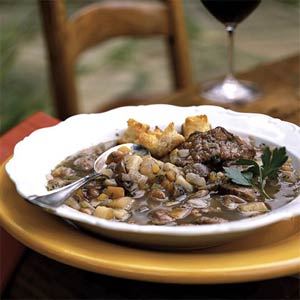

 The Accurate Reloading Forums
The Accurate Reloading Forums  THE ACCURATE RELOADING.COM FORUMS
THE ACCURATE RELOADING.COM FORUMS  Other Topics
Other Topics  Recipes for Hunters
Recipes for Hunters  Making "dried beef" (not jerky) from venison
Making "dried beef" (not jerky) from venisonGo  | New  | Find  | Notify  | Tools  | Reply  |  |
| one of us |
based on a lot of recent interest in this subject, and because i've always wanted to try making what is essentially a "ham" from venison, i decided to do some research and give this a try, using a hind quarter roast from a deer we shot this year. this project is a not-so-distant cousin to my pastramă project: http://foodsoftheworld.activeb...itle=project-pastram therefore, there will be some crossover, and concepts that work well there will similarly be effective here. here are some pictures showing a breakdown of muscle groups etc from the hind quarter of a deer. the pictures were lifted from another forum: http://www.archerytalk.com/vb/....php?t=730292&page=1 the link above has a lot of extra information that is very good for those of you looking for information on butchering deer; the method shown is very close to what we do with our own deer. after the hindquarter has been removed from the carcass, it is boned out. the complete, boned hindquarter will look something like this: 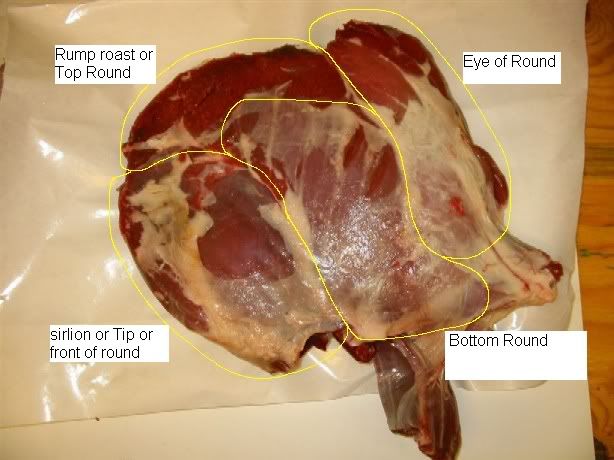 Picture Credit: http://i28.photobucket.com/alb..._quarter2small-1.jpg the mass above is separated into each individual muscle group (roast) and then trimmed of all fat, silverskin, membrane etc.: 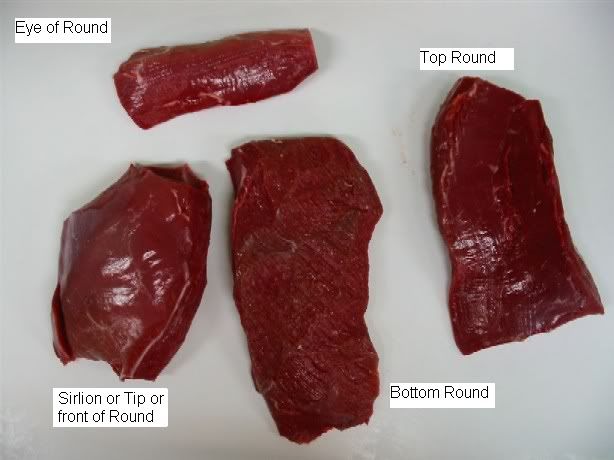 Picture Credit: http://i28.photobucket.com/alb..._quarter1small-1.jpg as mentioned above, this project will be similar to romanian pastramă, but will employ a simple cure consisting of brown sugar and morton's tenderquick. the finished product will not be unlike pastramă, or greek pastourma: http://foodsoftheworld.activeb...tourma_topic288.html or swiss bündnerfleisch: http://foodsoftheworld.activeb...leisch_topic548.html or even south african biltong: http://foodsoftheworld.activeb...iltong_topic214.html all of these products are cured, semi-dry cuts of meat; sometimes smoked, always preserved - delicious throwbacks to a time before refrigeration made it easy to keep perishable meats for long periods of time. if this were pork, we would call it a ham; however, the closest product to what we are making is referred to as "dried beef" (not to be confused with jerky); hence, the nomenclature. in some areas, the same product is also referred to as "chipped beef" - wikipedia elaborates on this:
since i am rather fond of the product, i've never felt the need to assign a derogarory term for it, and in my family it was simply known as "chipped beef." but i digress....here we go with the preparation of this product, which, for the sake of convenience, i'll simply call "dried beef." here's the aged and trimmed hind-quarter roast that i will be using, from our 2011 mule deer doe: 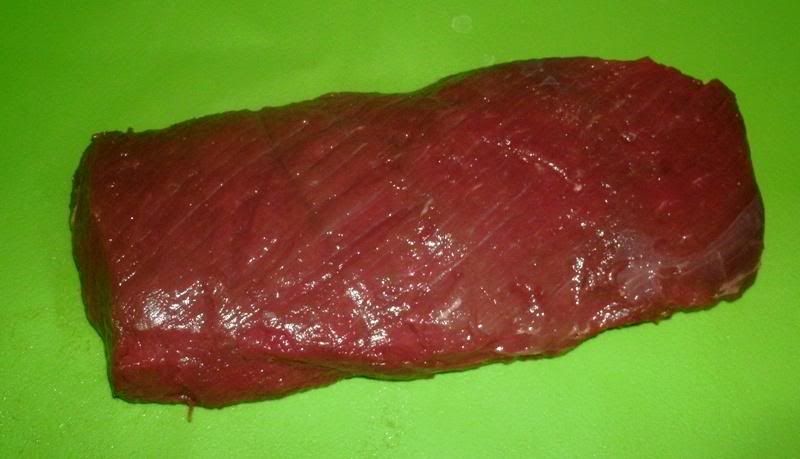 i always have trouble telling the top and bottom rounds apart, but i am pretty sure that it is the top round. as you can see, it's been trimmed of membranes, silverskin, fat etc. and is a nice, clean, wonderful hunk of good montana venison - all ready for the project! as any hunter knows, the weight of any venison roast varies according to the size of the deer, the amount of trimming necessary and other factors. i had actually bought a digital kitchen scale for this project (the only other one i had went to 1 pound only), but since i had misplaced the batteries (and they were those round, nickel-sized ones that aren't available in small towns on sunday evenings), i had to guesstimate the weight. i knew it was more than a pound, but not quite 2 pounds, so all of my measurements (cure, time for curing etc.) were for a 2-pound roast, in order to be on the safe side of the cure. since i was measuring for 2 pounds of meat, i used 2 tablespoons of tenderquick, according to package directions for a dry cure. since the roast was in actuality a little less than 2 pounds, the amount of cure was slightly more than recommended; however, it seems to me that it is better to have slightly more than less, as long as you don't go over by a large amount, especially in light of the lack of ability to get an accurate weight for the meat. for this simple fare, i wanted to use a simple cure and added only an equal amount of dark brown sugar to the tenderquick: 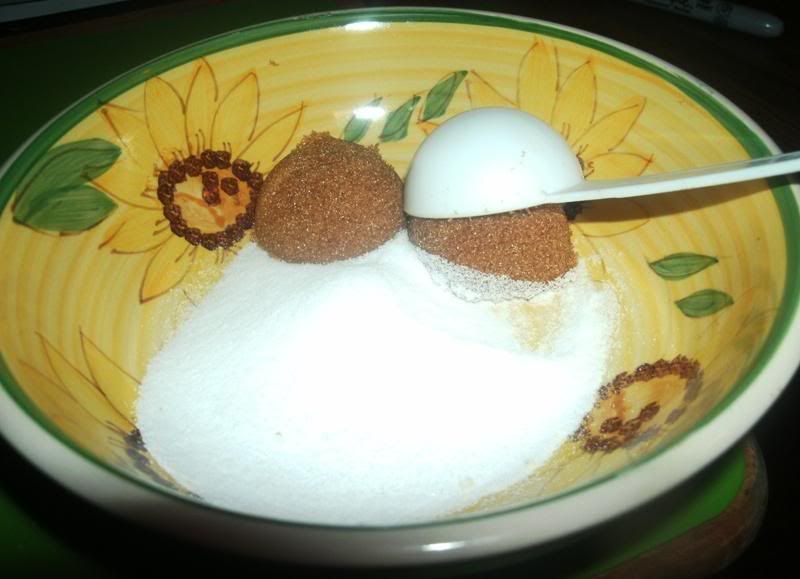 i then stirred the sugar and tenderquick together in order to blend them thoroughly: 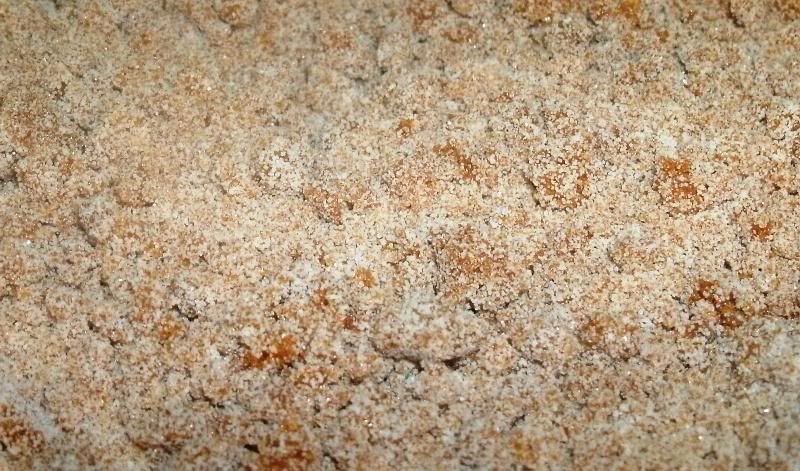 and applied the mixture to both sides of the roast: 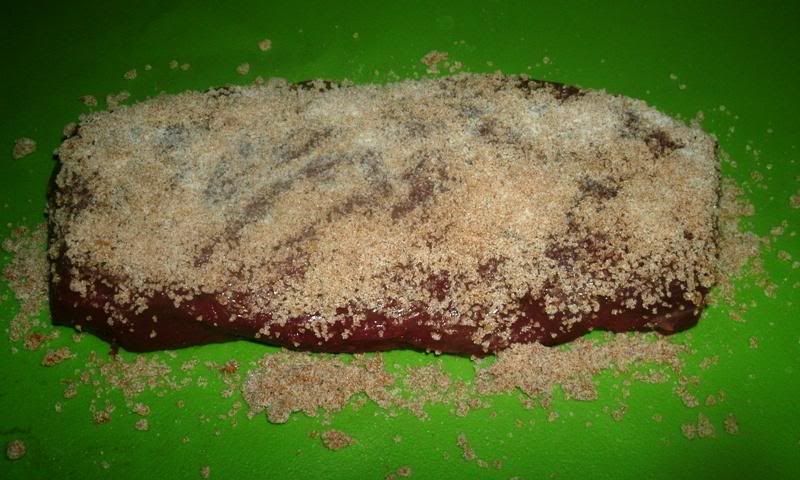 next, i laid the roast in a vacuum seal bag, then i emptied any "leftover" cure and sugar into the bag as well. since i prepared the roast on a flexible sheet of baking silicone, it was easy to fold and dump into the bag. then i vacuum-sealed and labeled the bag: 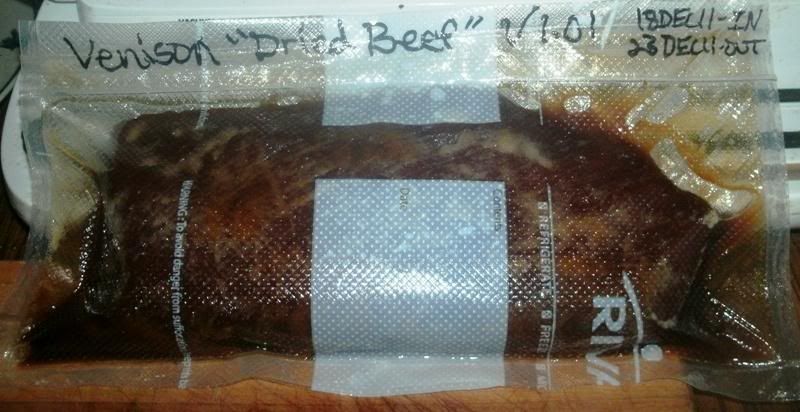 the vacuum-seal method worked very well during my most recent gravlax project: http://foodsoftheworld.activeb...-new-gravlax-project so i decided to use it for this curing project as well. the vacuum seems to help with the absorption and osmosis that take place during brining, and the seal of course prevents any chance of leakage. for the label, i included the project, the date i began the cure and the date that the cure would finish. since the meat was between 1 and 2 inches in thickness, i calculated a curing time for 2 inches, consistent with the recommendations found here: http://foodsoftheworld.activeb...rquick_topic935.html the total came to 4 days of curing time, but i am adding a little time for safety and - let's face it - to get me to the weekend so that i would actually be able to work on the project. then, i put the roast in the refrigerator in order to let the cure work its magic. i've been turning and massaging the meat once each evening, in order to ensure that the cure is well-distributed. that's it for now - more as it develops..... | ||
|
| one of us |
When we last left you, Dear Reader, we had just put the venison roast and cure into a vacuum-seal bag and into the refrigerator to cure for at least 5 days. As it turned out, I didn't get to continue this project until the evening of the 25th of December, so it was a few more days than that, but no worries - a little bit of margin is just fine! Here we are after 7 days of curing, turning, massaging and light pressing:  I'm not sure if all of the steps above are necessary, considering the vacuum seal, but as I've said before, it sure didn't hurt. You can see that the curing process brought out quite a bit of moisture, and the venison has taken on a beautiful colour. I soaked the roast in ice-cold water for half an hour, in order to draw out excess saltiness: 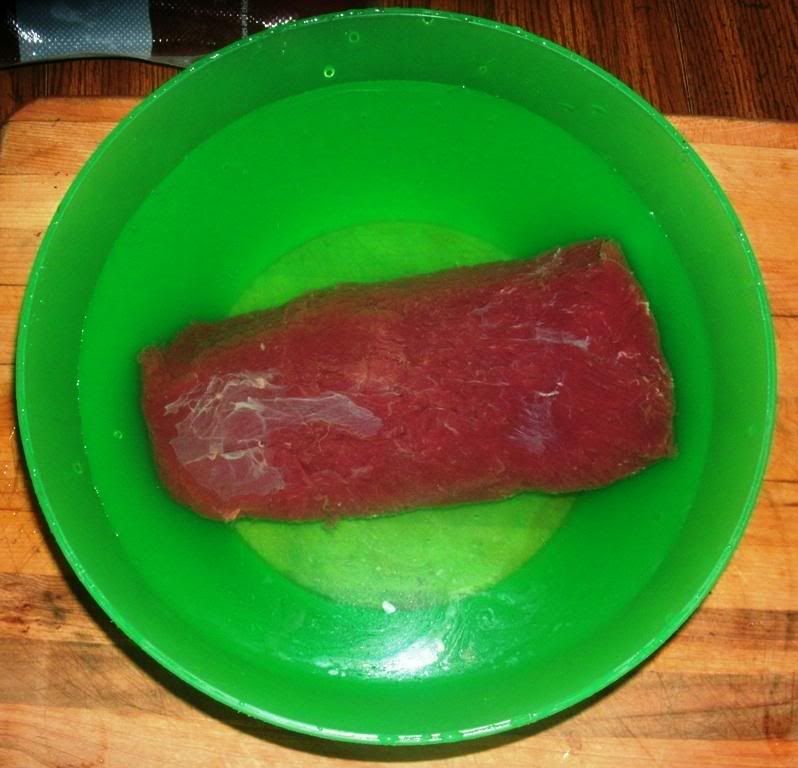 We didn't have any ice, so I kept it in the refrigerator for the allotted time in order to keep the meat as cold as possible. At this point, most folks do a "fry test," which involves slicing off a bit of the roast, frying it, and sampling it to see what the salt content is like, to determine if it needs to soak longer or not. I skipped this step, purely on a whim, but the "fry test" is advised, so that you can avoid any surprises that might hurt your chances for success. Next, I ground some fresh, black pepper over both sides of the cured roast and set it out on one of my smoker racks: 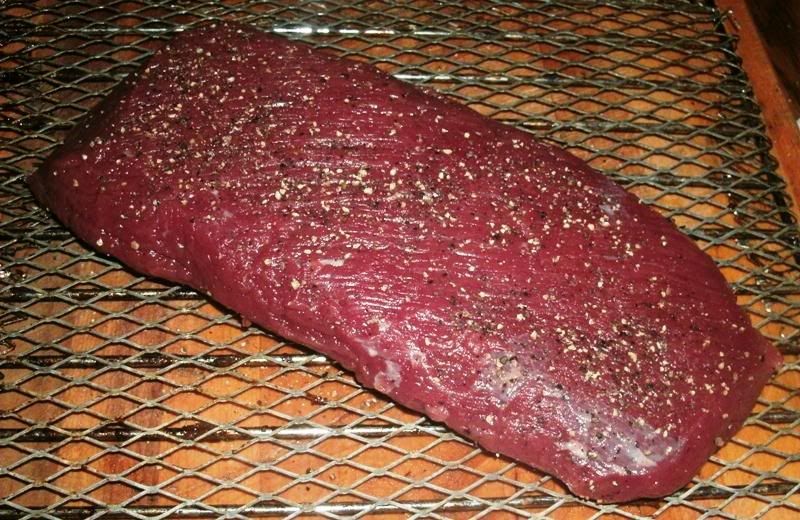 And put it in the refrigerator overnight, uncovered, in order to form a pellicle, which is nothing more than a slightly dry, slightly tacky surface; the pellicle helps with smoke penetration and a better final product. The next day, I set up my Little Chief and began smoking the roast over alder wood chips, which I felt would be a great compliment to the venison. The Little Chief is perfect for projects like this, which call for cooler smoking temperatures rather than "smoke cooking." Smoking is optional, but highly recommended for a wonderful touch. I found alder to be perfect for the venison, but that's no reason not to experiment. I imagine cherry, apple or maple would really be something, while hickory, oak, pecan or mesquite would lend wonderful properties of their own. Your imagination is your only boundary. After 8 hours or so of smoking, with some drying, here's what we had: 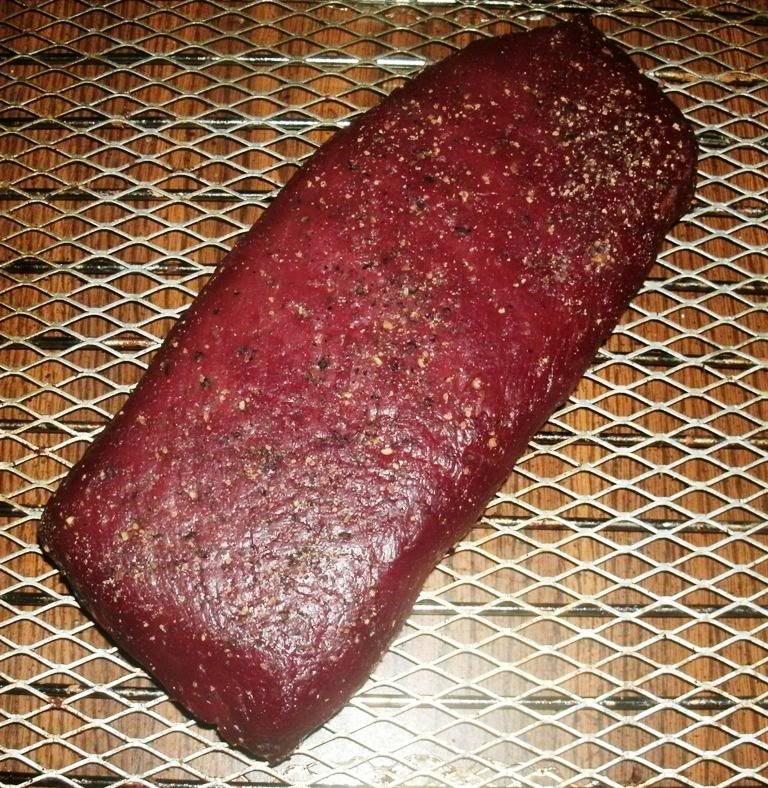 The aroma was outstanding, with the subtle alder adding a perfect undertone to the sweet-spicy smell of the venison, which had developed a semi-hard, semi-dry outer surface. It can't really be called a "crust," because it wasn't hard, but at the same time, it was firm. The best way to describe it would be an outer skin that was almost like a casing on a sausage. The interesting thing about this is that it allows the meat inside to stay just about right - not too moist and not too dry - while allowing the seasonings, cure and smoke to work their magic. For this project, I chose to finish it inside, so I put the rack in the oven on the lowest setting for about 3 hours, to get it up in the 155-160-degree range. I apologize that I can't be more precise, but it seems that my temperature probe thermometer was "misplaced" since I used it last. Children are the joy of life, but at times it is a challenge to remember that. In any case, here's how we looked after some time in the oven to come up to temperature: 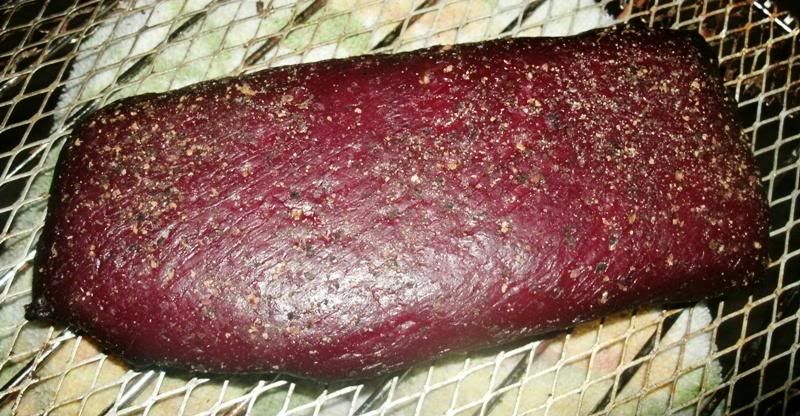 At this point, I let the roast cool down in the oven for a couple-three hours, until there was no appreciable heat to it, then put it in a ZipLock bag with the air pressed out and placed it in the refrigerator for the rest of the evening and the next day. When I got home from work, I was eager to see how it turned out, and also to try out my new meat slicer. I removed the venison from the refrigerator and took it out of the ZipLock. There were a few drops of residual moisture that had settled to the bottom of the bag, but only a few, and there's how the roast looked: 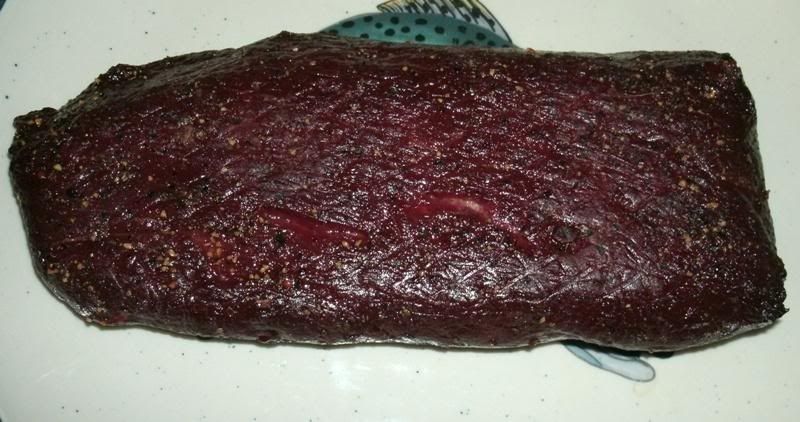 I set up my slicer, and then cut the roast in half so that slicing would be easier (from the middle-out, so to speak): 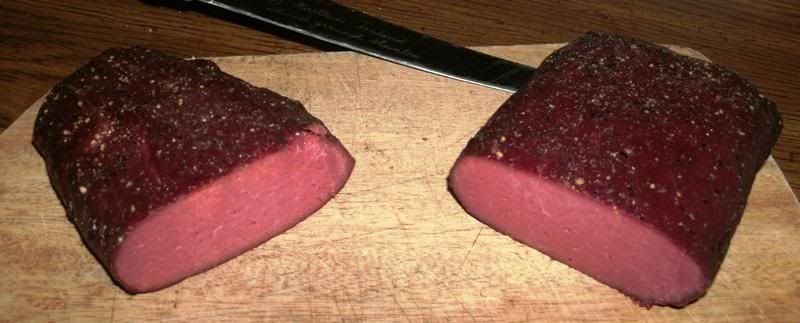 Looks pretty good! It reminded me a lot of the gravlax project I did: http://foodsoftheworld.activeb...oject_topic1105.html As you can see, the cured meat in both cases is dry, yet moist; firm, yet soft. Henceforth, this product shall be referred to as "dried beef," even though it was by no means dry, and of course it isn't beef; that's simply what it's called, and that's what I'm going to call it ~ Eagerly, I began slicing; my goal was to get the thinnest slices possible, but there was a bit of a learning curve on this first slicing attempt: 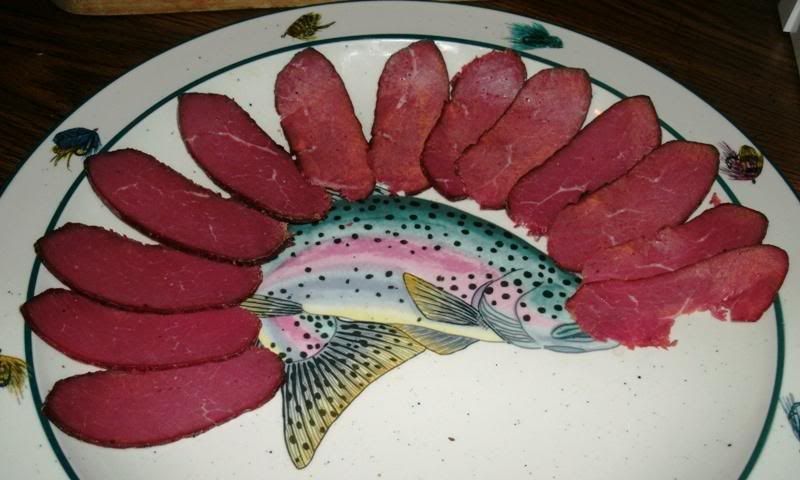 However, once I got the hang of it, I was able to do pretty well: 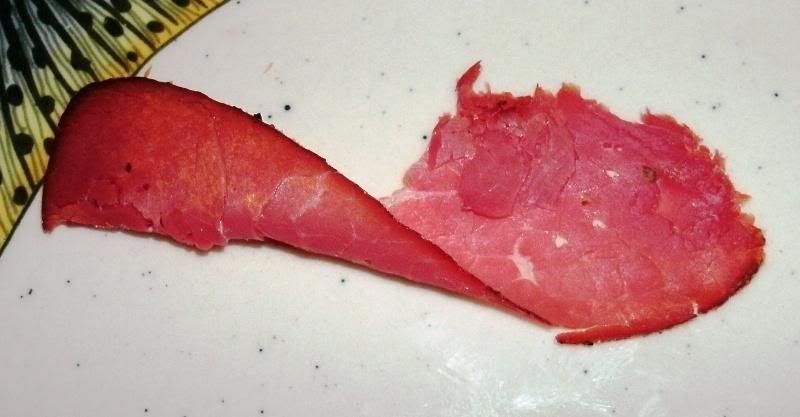 Here's the first "half" of the dried beef: 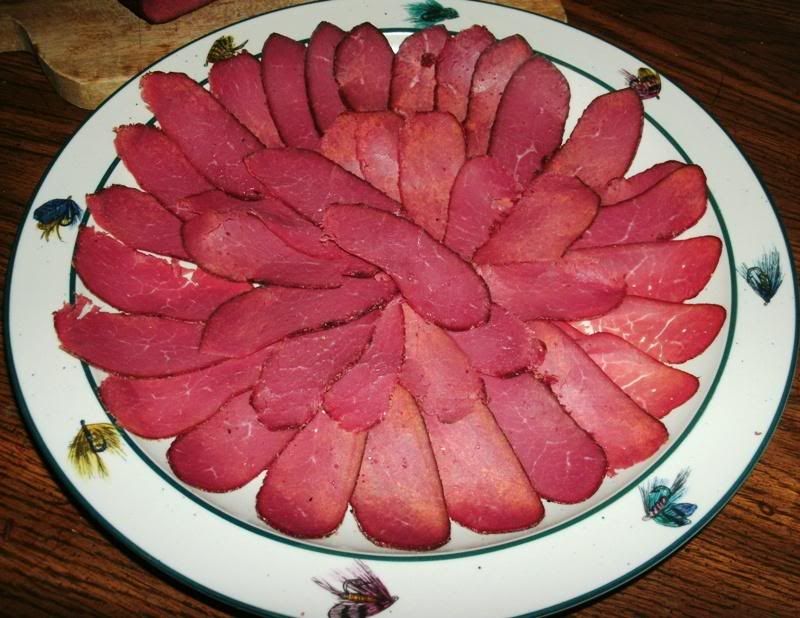 The lighter spots that you see toward the bottom are washout from the flash; also, there may be a few slices missing, as everyone was in sample mode. I tried a piece myself, and WOW this stuff came off just right. The first piece I tried was one of the thicker pieces ( "thicker" is a relative term; it really was quite thin), and was impressed at the complex result of such simple ingredients: cure, brown sugar and black pepper sprinkled on the outside - that's it, and that was really all it needed for an amazing result. Then, when I tried one of the wafer-thin pieces that were nearly transparent, I was completely blown away even farther as it practically melted on my tongue into an array of flavours that seemed to come from all sides. This stuff is wonderful, and certainly not the same "chipped beef" that we loved (or hated) as kids! I continued to slice until both halves were finished: 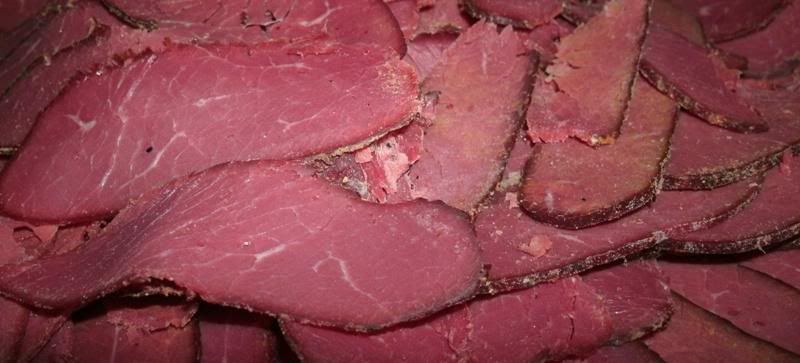 And then separated the slices into two piles based on thickness: 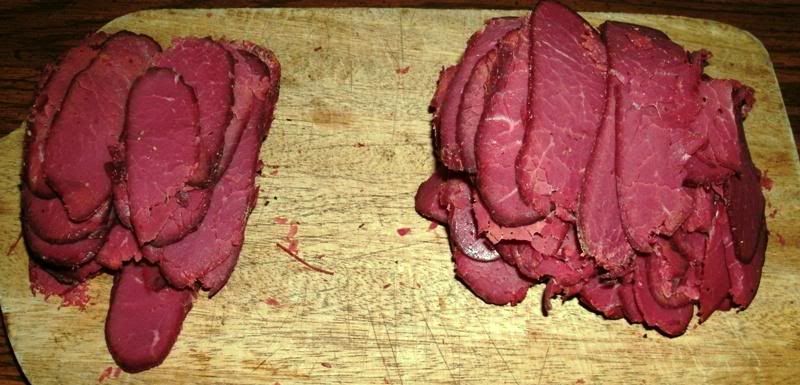 I wanted to keep the magnificent, super-thin stuff separate, so that I could lay those wonderful slices of goodness out on a meat-and-cheese tray sometime. The other pile will be used for sandwiches, or perhaps chopped and worked into a white sauce and put over biscuits, in the not-too-distant future. I then vacuum-sealed the packages: 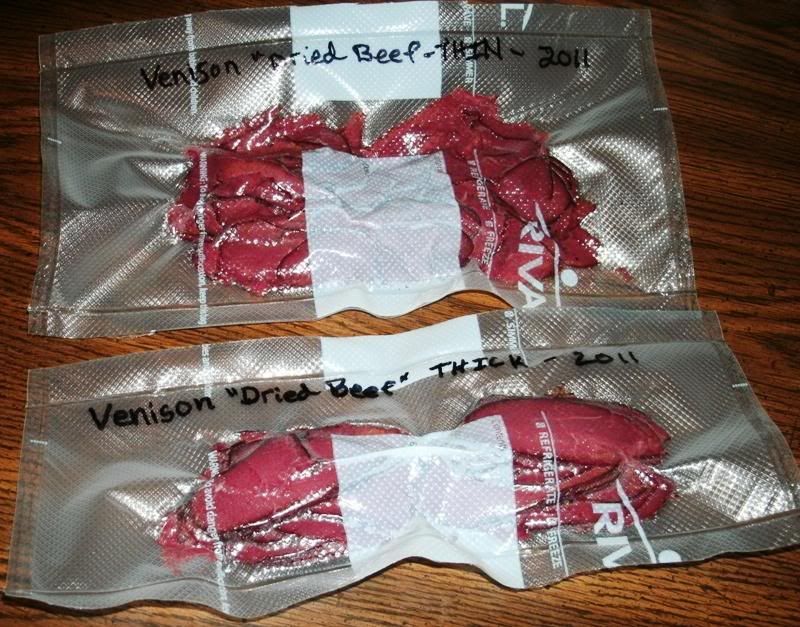 And put them in the freezer. I cannot say too many good things about this product. It is easy, tastes great, and is a good use of venison. It's also versatile, as the preserved meat can be eaten on it's own or worked into nearly any dish. It's similar to ham, but with flavours, properties and character all its own. Naturally, this process can also be used with just about any meat, including, of course, beef; any meat that can be cured can be given the "dried beef" treatment. That pretty much concludes my venison "dried beef" tutorial, and it is certainly one for the books! I cannot recommend this stuff enough, and am very glad that I took the leap into trying it. It was new territory for me, and I will admit there was a huge satisfaction at putting out something so good at the first attempt. Thank you for looking, and I hope that you are inspired to try this. I believe I covered the process quite well, but if anyone has any questions at all, please ask. | |||
|
| One of Us |
This looks wonderful. Cal30 If it cant be Grown it has to be Mined! Devoted member of Newmont mining company Underground Mine rescue team. Carlin East,Deep Star ,Leeville,Deep Post ,Chukar and now Exodus Where next? Pete Bajo to train newbies on long hole stoping and proper blasting techniques. Back to Exodus mine again learning teaching and operating autonomous loaders in the underground. Bringing everyday life to most individuals 8' at a time! | |||
|
| One of Us |
When I hunted in Namibia two years ago there was some meat served at brunch that looked awfully like this. It appeared to be cured,dried and lightly smoked just like yours. I've got to give this a run. | |||
|
| one of us |
things like this are almost universal - air-curing of meat has been practiced, in one form or another, almost everywhere. this version is quite easy, and certainly worth a try! | |||
|
| one of us |
Bump for lavaca ~ | |||
|
| One of Us |
Mouthwatering! | |||
|
| One of Us |
Thank you. Explained well and the pics just magnify the explanation! Jim | |||
|
| one of us |
If it tastes anything like it looks; you nailed it. Great photography work. I have a feeling that if I print the pages, and eat them, the flavor would still come through. I can see from this that in my deer hunting days I just never thought outside the box. I'm assuming by "deer" you mean mule deer, which makes me just wonder how good this would be with axis deer; my favorite. Axis (chital) always seemed to put mule deer and whitetail in the shade taste-wise. | |||
|
| one of us |
Thanks much for the comments, guys - Kensco, it should work great for axis deer or any other; antelope, moose, pretty much anything. One of the great things about it is that the size of the cut doesn't matter too much because it's about the method, which can be adjusted for big or small projects. | |||
|
| one of us |
Looks and sounds mouth-watering. Starting the cure in a few minutes, on the same cuts from a doe my son got. Will let y'all know! NO COMPROMISE !!! "YOU MUST NEVER BE AFRAID TO DO WHAT IS RIGHT! EVEN IF YOU HAVE TO DO IT ALONE!" | |||
|
| one of us |
Wingnut - good luck! Keep us informed how it goes, and ask if you ahve any quesitons. NOTE - if you use a cure OTHER THAN Tender Quick, follow the directions for that cure per pound of meat. you may also need to add salt. | |||
|
| one of us |
Sorry, didn't get pics. Followed instructions for curing. But..... My cuts of meat were from a DEEEP south whitetail doe - not nearly as large as Tas'. I cold-smoked a little longer than called for, approx. 7 hours at 130 deg. F. Then hot-smoked at 200 deg. for about 2 hours. Internal temp at the thickest part of the meat was 162 deg. Let the meat cool, then sliced. Wonderful is not a good enough adjective!! A little dryer than Tas' appears to be in his photos, which is exactly what I wanted. THANK YOU, TASUNKAWITKO! THIS RECIPE WILL BE IN MY PERMANENT ROTATION!! Will be trying this on cuts of pork from a 200-lb. feral sow next, starting the weekend of 21 March 2014. Think I'm going to try brining instead of dry-curing on some of the cuts. NO COMPROMISE !!! "YOU MUST NEVER BE AFRAID TO DO WHAT IS RIGHT! EVEN IF YOU HAVE TO DO IT ALONE!" | |||
|
| one of us |
Sounds great - very glad that you enjoyed this! I love the stuff, and it is definitely one that will be made again and again. Yes, if you do this with wild boar, it will be very similar to a ham. Be sure that the meat is cooked thoroughly in order to prevent infection from trichinosis ~ Other than that, you should be good to go! Keep us informed ~ Ron | |||
|
| one of us |
I am going to try your recipe. Just last night and today I ate some wild turkey thigh that I had mesquite smoked at the deer leaase and it was great. Your deer "dried beef" looks like something perfect for a meat,cheese and cracker plate. What I call a MCCP, which I eat a lot for lunch and a late night snack. DOUBLE RIFLE SHOOTERS SOCIETY | |||
|
| one of us |
NE - your MCCP is exactly what I like to do with this stuff. Another good thing, of course, is doing the "chipped beef" sandwiches. Many other uses. Think of it as a "ham" made from deer, and before long you will see how many good ideas you can come up with! | |||
|
| Powered by Social Strata |
| Please Wait. Your request is being processed... |
|
 The Accurate Reloading Forums
The Accurate Reloading Forums  THE ACCURATE RELOADING.COM FORUMS
THE ACCURATE RELOADING.COM FORUMS  Other Topics
Other Topics  Recipes for Hunters
Recipes for Hunters  Making "dried beef" (not jerky) from venison
Making "dried beef" (not jerky) from venison

Visit our on-line store for AR Memorabilia

